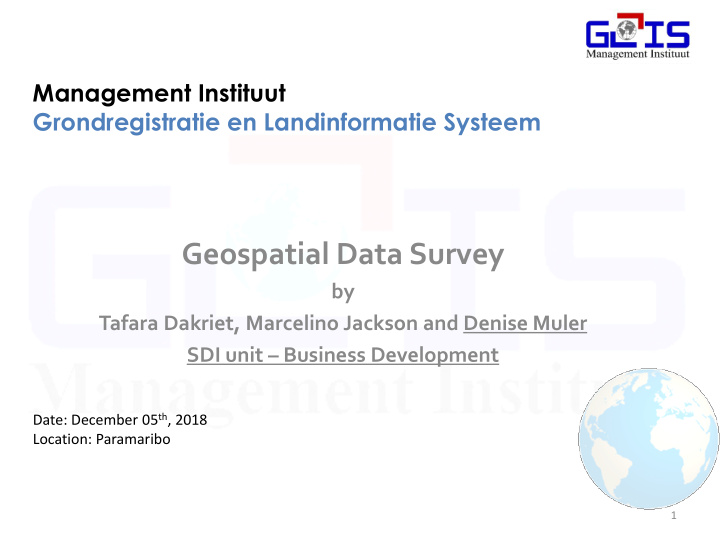



Management Instituut Grondregistratie en Landinformatie Systeem Geospatial Data Survey by Tafara Dakriet, Marcelino Jackson and Denise Muler SDI unit – Business Development Date: December 05 th , 2018 Location: Paramaribo 1
Topics • Definition SDI? • SDI Components • Aims National SDI • Role MI-GLIS and partners • Spatial data research results • Examples of SDIs • Next steps 2
Definition SDI A Spatial Data Infrastructure ( SDI ) is a data infrastructure implementing a framework of geographic data, metadata, users and tools that are interactively connected in order to use spatial data in an efficient and flexible way. An SDI is a coordinated series of agreements on technology standards, institutional arrangements, and policies that enable the discovery and use of geospatial information by users and for purposes other than those it was created for. 3
SDI Components Policy Is data free, what Network Standards are the costs, who infrastructure is the owner? Is the data accurate Can the data be and up to date? queried? Metadata Partnerships Which data and How is data shared how is it collected? with organizations? SDI Capacity building Data layers How to use Which data is available shared? technology? 4
Aims National SDI • The MI-GLIS institute aims to – Promote/stimulate the digitization of spatial data – Share spatial data with the public and private sector – Set up a knowledge network with organizations, who can contribute to the SDI – Provide the government with an instrument for better policy decisions at all levels – Increase the competitive position of companies, e.g. project developers can determine their price based on the value of land 5
Role MI-GLIS and SDI partners MI-GLIS Coordinator National SDI Role: Ensuring up-to-date and authentic spatial information Geospatial a) Policies regarding metadata and standards Data b) The preservation of Spatial data in a standardized manner Warehouse c) Providing authentic and up-to-date basic Spatial data Spatial data end-user SDI partners Role: Role: a) Periodically upload relevant Spatial data Consulting relevant spatial b) Exchange up-to-date and authentic Spatial data / information information 6
Spatial data research Organizations visited (15 total): • Algemeen Bureau voor de Statistiek (ABS) • Celos/Narena • Energie Bedrijven Suriname (EBS) • Geologische Mijnbouwkundige Dienst (GMD) • ’s Lands Bosbeheer (LBB) • Ministerie van Handel, Industrie & Toerisme (HI & T) • Ministerie van Landbouw, Veeteelt & Visserij (LVV) • Ministerie van Openbare Werken, Transport & Communicatie (OWT& C) • Ministerie van Regionale Ontwikkeling (RO) • Maritieme Autoriteit Suriname (MAS) • Stichting Natuurbehoud Suriname (Stinasu) • Stichting Bosbeheer en Bostoezicht (SBB) • Stichting Planbureau Suriname (SPS) • Staatsolie Maatschappij Suriname N.V. (Staatsolie) • Telecommunicatiebedrijf Suriname (Telesur) 7
Spatial data research Findings listed under 5 components SDI Framework • Data component • People component • Access network component • Policy component • Standards component 8
Data component Availability of data sets Basic data • Geodetic network (CORS + several monuments ) • Raster (basemaps) • Vector data (polygon, line and point layers) • Core business depends on technology and geodata (10) • Technological facilities not present, but awareness is (4) • No awareness regarding technology and geodata (1) • Organizations cautious about exchanging confidential and/or sensitive data • Fear that with the NSDI, MI-GLIS wants to profit from their data 9
People component Educaction, Human capital, SDI awareness, Willingness to share data • Knowledge present and applied (8) • Knowledge present but not applied (1) • No knowledge / awareness (2) • No finances and resources to gain knowledge (1) • No / Insufficient experienced SDI experts • Training sessions are given by foreigners • SDIs initiated and financed by international (UN) organizations • Trained personnel leaves the organizations when there is a lack of finances to support much needed technology 10
Access network component Access (delivery) mechanism • Standalone (1) – Internal use • Exchange (7) – With other organizations • Intermediair (1) – NSDI vision present, action plan, (potential) coordinator SDI • Network stage (none) – Standards for general use, national support for SDI, preparing for connection to international SDIs 11
Policy component Funding, Leadership, Vision, Institutional arrangement, Social political stability • No funding – Central location, software/hardware, training • SDIs in certain fields – Forestry, environment, census, hydrology • Policies, systems and processes not present – No documented vision for an NSDI – No national standards • Social political instability hinders decision making 12
Standards component Interoperability, metadata Geospatial interoperability : The ability of different geographic information systems to share, exchange, and operate (heterogeneous) geospatial data and functions. Metadata : Documentation about who, when, where, what, why, how of the data and the data production process. Metadata can be used for describing data, tools, services, and other geospatial resources. • Protocols for data exchange with public and private sector (2) • Sharing information from official data sources (as needed) • Data is provided (one way) not exchanged (vice versa) • Regulations and administrative requirements (not available) 13
Standards component Examples of Geospatial standards in Suriname: Organization Standards NH/GMD The land surveyors were asked to use the WGS 1984 coordinate system and place the coordinates (x,y) on their maps. New Mining Act: Proposal to use WGS 1984 UTM Zone 21N projection instead of the Stereo graphic projection MI-GLIS General Surveyor Instructions 14
Examples of SDIs • Examples of SDIs – Europe: INSPIRE – Latin America and the Caribbean: GEOSUR – Jamaica: DRIP 15
Next steps • The Basemap for Suriname • Set up a knowledge network – Promoting cooperation between (government) organizations – Mutual exchange of technical knowledge, lessons-learned, best-practices and sharing case studies – Assess availability and accessibility of high-quality geospatial information and services • Visit www.miglis.sr 16
Recommend
More recommend